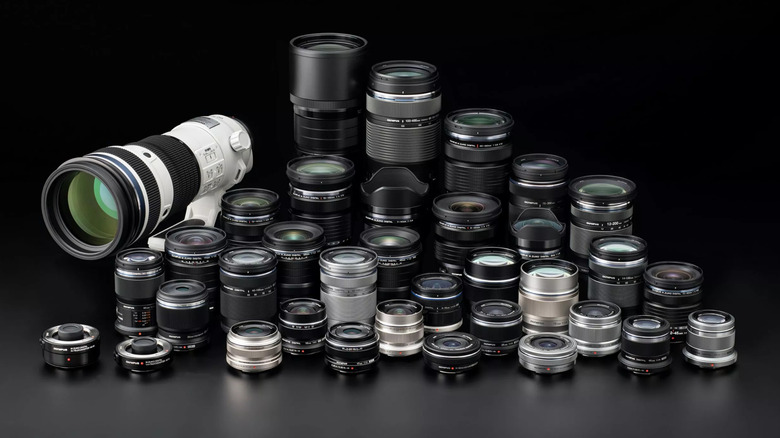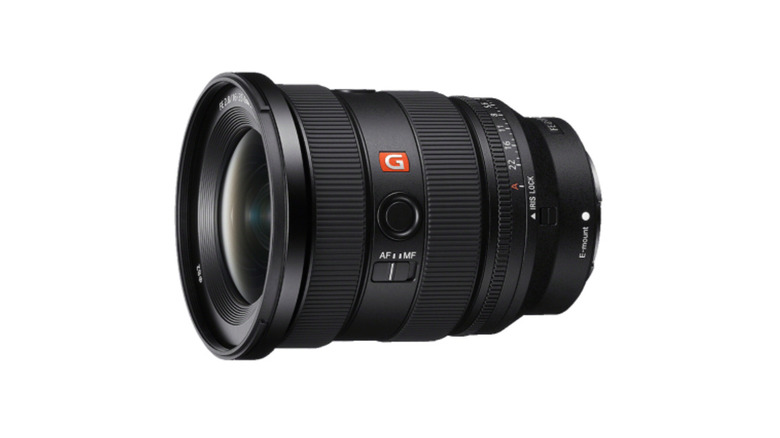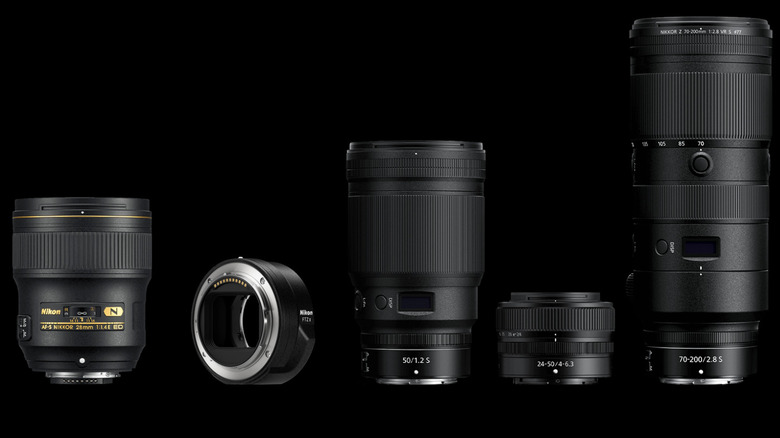Every Major Camera Lens Brand Ranked Worst To Best
We may receive a commission on purchases made from links.
When it comes to interchangeable lens cameras -– DSLR and mirrorless both –- a capable camera body from a reputable brand is only one part of the equation. The other equally crucial component is the lens, as your choice of optical glass can determine how well your camera handles different shooting situations. To evaluate the major camera lens brands, we assessed the variety and quantity of lenses available by each manufacturer. Lenses vary in quality, even when coming from the same manufacturer. The overall performance of, say, a Canon RF L-series professional lens is very different from what you get from a garden variety RF lens.
We looked at the available focal lengths, f-stops, and other niche specialties among prime, telephoto, and zoom lenses. The wider the aperture of the f-stop, the more light the lens allows into the camera. That's why f/2.8 lenses are a great choice for low-light situations and the same goes for lenses with apertures as low as f/1.2. The wider the aperture, the more bokeh you can achieve in the background. Bokeh, of course, refers to the dreamily blurred backgrounds you see in images, which in turn calls more attention to your intended subject.
Each camera manufacturer has its own mount and electronics, and you can generally expect the best performance out of an original equipment manufacturer (OEM) lens (as in, a Nikon lens on a Nikon camera). However, Sigma and Tamron are both third-party manufacturers of camera lenses across multiple mount systems and sometimes they offer lenses with different specs than the OEM options. With all that out of the way, let's dig deeper into the major camera lens brands.
8. Tamron
Tamron is a venerable Japanese maker of third-party lenses with history that goes back to the 1950s. The company offers lenses across a wide range of camera mounts across the DSLR and mirrorless markets, including Sony E, Fujifilm X, Micro Four Thirds, and Canon EF. It also offers both Nikon F (DSLR) and Nikon Z mount lenses.
The company currently offers 28 lens models available on its site. Of those, 20 are for mirrorless camera mounts. Some lenses are available for more than one mount system, which is why 18 of the 20 models are for Sony E-mount. That leaves eight models for older Canon EF and Nikon F DSLR mounts, all but two of which are available for either mount. For example, the company has a 35-150mm f/2-2.8 lens for the Sony E-mount, and it just released a version for the Nikon Z-mount. Similarly, the 17-70mm f/2.8 is available for both Sony E-mount and Fujifilm X-mount.
While Tamron has had a history of offering more affordable versions of lenses made by OEMs, the company also focuses on finding new sweet spots not addressed by an OEM's stable of lenses. For example, Tamron bills the 17-50mm f/4 wide-angle zoom lens for Sony's E-mount as the first wide-angle zoom for a full-frame camera. The lens costs $699 at B&H Photo and offers a consistent aperture across its zoom range.
7. OM System USA
Olympus remains a familiar name in the world of photography even though the company has had some rough transitions in recent years. The consumer photography and audio lines were relaunched under a new owner and new corporate branding, OM System USA.
Over the years, Olympus built a reputation for its sharp glass, and OM System lenses continue that tradition. The company lists about 30 lenses on its site, all using the Micro Four Thirds mount. That means the OM System lenses can work with Panasonic's L-mount systems, which are compatible with Micro Four Thirds. However, OM System bodies are attuned to the company's own lenses — you can expect to lose some autofocus and image stabilization functionality if you use a Panasonic lens on an OM System body.
OM System has lenses across wide-angle zoom, standard zoom, telephoto zoom, and prime focal lengths. One of the newest lenses is the M.Zuiko Digital ED 90mm F3.5 Macro IS PRO, which sells for $1,299 at B&H Photo. This lens has a minimum focal distance of 8.8 inches, making it perfect for getting close to your subject. It also has IP53 protection against dust and water, so you can take it into the field without worrying about damaging the lens.
6. Sony
When Sony first got into the digital photography game, it had two mount systems — the older Sony A-mount for legacy camera bodies and the newer E-mount. However, the A-mount system is long gone, and with it went Sony's A-mount lenses. This leaves the company's range of E-mount lenses with over 30 designed for full-frame cameras and nine for APS-C systems.
As with its bodies, Sony's lenses can be surprisingly light. Even its 400mm f/2.8 is light enough to hand-hold for extended periods — something that's virtually unheard of for that focal length. Sony's lineup of lenses covers a wide range of creative scenarios, and it has several that are appropriate for sports, including the FE 85mm f/1.4, the 135mm f/1.8, and a more basic 35mm f/1.4 full-frame lens. Oddly, Sony still doesn't have a 300mm f/2.8 lens, a sports mainstay despite the company's push into sports photography.
The FE lenses are a bit larger than Sony's APS-C lenses, as is typical across camera lines. They're also more capable, with better optics and wider apertures for shooting in tricky lighting. New to the line is the Sony FE 16-35mm f/2.8 GM II, which delivers improved performance on Sony's lightest wide-angle zoom. Buy it for $2,298 at B&H Photo.
5. Panasonic
Panasonic's full-frame Lumix cameras use the L-mount system. Since Leica and Sigma also use the L-mount, it means that Panasonic camera owners have additional flexibility when considering what kind of lens to buy. Panasonic's website lists a wide swath of options, showing 51 lenses across its APS-C G series and its full-frame S series lenses. This gives anyone using the Lumix, Leica, or Sigma systems — from beginners to professionals — a wide array of choices to find a lens that will suit their needs.
The lineup lacks some common options, like a 300mm f/2.8 lens, but those may not be necessary considering Panasonic's bodies aren't synonymous with sports photography. The lens styles range from pancake primes and telephoto zooms in the G Series to low aperture primes and zooms in the S series. Both series have zoom lenses with constant f/2.8 or f/4 apertures –- an uncommon touch among APS-C-specific lenses. One strong example is the G Series 35-100mm f/2.8, which is available for $798 at B&H Photo.
4. Fujifilm
Fujifilm actually has two lines of camera lenses. At the high end, the company's GFX mirrorless system forges ahead by making medium-format bodies with their large 55mm sensor more accessible to enthusiasts and pro consumers. Below the GFX system sits Fujifilm's compact APS-C cameras, like the Fujifilm X-T5. Together, Fujifilm currently offers 54 lenses in all (not counting cinema lenses) -– 17 G-mount lenses and 37 X-mount. The X-mount lenses heavily favor prime lenses, with 23 primes and 14 zooms in the mix. The two mounts are not compatible with one another, so be sure to shop for the lens that works for your camera body.
Among its G-mount offerings, Fujifilm says it will be the first company with a tilt-shift lens for a medium format mirrorless system. As for X-mount lenses, Fujifilm points to the 35mm f/1.4 lens as one of its more popular lenses. It's easy to see why. Not only is it among the more affordable lenses in Fujifilm's lineup — you can buy it for $599 at B&H Photo – but its effective 53mm focal length hits close to what our eye can see. This lens makes a great choice for street photography, for example.
3. Sigma
Sigma is another third-party Japanese lens manufacturer with a history that goes almost as far back as Tamron. Sigma's lenses are entirely made in Japan and the company stands out for its wide variety of lenses across a multitude of mount systems for mirrorless and DSLR cameras, including Canon EF, Canon EF-M, L-Mount, Nikon F, Nikon Z, Sony E, Sony A, and Sigma SA.
As with Tamron, the bulk of Sigma's mirrorless lens models are available for Sony E-mount. The company has 62 lenses listed on its site that are fairly evenly split between mirrorless and DSLR. Regardless, Sigma clearly has a wide variety of lenses for use with different mount systems–and many lens models are available for two or more mounts.
Sigma classifies its lenses not just by mount but also by purpose. For example, you can search the company's site for lenses billed as art, sports, or contemporary. Sports is self-explanatory, with long reach, low-light handling, and fast autofocus. Art lenses are aimed at creatives, while contemporary lenses showcase high performance.
In 2023, Sigma added to its initial Fujifilm X-mount lenses with models like the 23mm f/1.4 lens. On an APS-C camera, 23mm is roughly equivalent to 35mm on a full-frame camera. Its low f/1.4 aperture is ideal for use in low light and the lens sells for $549 at B&H Photo. The company also released a trio of Nikon Z-mount lenses, their first for Nikon's mirrorless system. The three lenses –- 16mm, 30mm, and 56mm -– all have a wide-open f/1.4 aperture. Those same focal lengths were previously available for Fujifilm X and other mounts.
2. Nikon
Nikon's stable of lenses embraces both its older DSLR formats and its contemporary Nikkor Z mirrorless lenses. The company has a whopping 123 lenses active on its site. Of those, 84 DX and FX Nikkor F-mount DSLR lenses are available, despite Nikon sunsetting dozens of lenses in recent years. The DX lenses were optimized for Nikon's APS-C DSLR bodies, while the FX lenses were optimized for the full-frame DSLR cameras. If you have a cache of old glass and want to move to mirrorless, the Nikon FTZ II adapter lets you use older DX and FX lenses on a Nikon Z mirrorless mount.
Notably, Nikon has 39 Nikkor Z mirrorless lenses available for its Z-Mount mirrorless cameras. Of those, 21 are Nikon's top-shelf S-Line, which has a redesigned optics subsystem to deliver sharp, dimensional imaging for both stills and video.
Ironically, even though Nikon has rapidly expanded its line of Z-mount lenses, the company has had little in the way of innovation or new releases among its camera bodies. This is one reason why Nikon was absent from our list of the most popular mirrorless cameras and why we bumped Nikon down to the second slot.
1. Canon
Canon has a diverse lineup of legacy and contemporary lenses to accompany its range of mirrorless and DSLR cameras. The company's EF DSLR lenses have a rich history of precision optics, as was once laid out in exquisite detail in a 2003 Canon book titled "EF Lens Work III: The Eyes of EOS." Fast forward 20 years and Canon is still renowned for its glass with nearly 100 lenses across four lens mounts, each tailored to different camera systems and sensor sizes.
Despite ceasing production on a multitude of EF lenses over the past couple of years, Canon says it still offers 43 EF-mount lenses for its full-frame and APS-C DSLR cameras and six EF-S lenses for its APS-C DSLR cameras. Adding in another five tilt-shift lenses gets you to a count of 54 DSLR-era lenses. These EF lenses form a healthy foundation of glass you can use on Canon's flagship RF-mount, the new standard for its mirrorless cameras. An adapter lets you use any EF lens on an RF-mount, a convenience that makes the shift from DSLR to mirrorless smoother.
That said, Canon has an aggressive agenda for its RF lenses. It already has 33 RF lenses on the market and three RF-S lenses (for its APS-C mirrorless cameras), and more are on the way. This year saw the release of three noteworthy lenses. The RF 100-300mm f/2.8 is an indoor sports photographer's dream lens for its flexibility and constant aperture, the RF 135mm f/1.8 is a great choice for portraits, and the RF 28mm f/2.8 STM is a pancake-style prime lens that's great in low-light situations.








